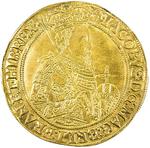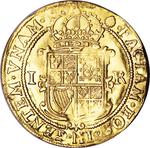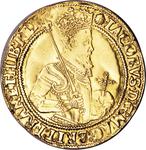Information about effigy: Coat of Arms of England, 1603
|
Following the death of Queen Elizabeth I in 1603, the throne of England was inherited by the Scottish House of Stuart, resulting in the Union of the Crowns: the Kingdom of England and Kingdom of Scotland were united in a personal union under King James VI and I. As a consequence, the royal arms of England and Scotland were combined in the king's new personal arms. Nevertheless, although referencing the personal union with Scotland and Ireland, the royal arms of England remained distinct from the royal arms of Scotland, until the two realms were joined in a political union in 1707, leading to a unified royal coat of arms of the United Kingdom. Formally described, the arms are: Quarterly of 4: 1st & 4th grand quarters: quarterly of four; 1&4: France; 2&3: England (Plantagenet); 2nd grand quarter: Scotland; 3rd grand quarter: Ireland. In other words, the shield is divided into four parts. The upper left is itself divided into four, with the arms of England (three walking lions) represented twice - above right and below left, and the arms of France represented twice - above left and below right. In the upper right quarter, the arms of Scotland - a rampant lion surrounded by a double line. The lower right quarter is the same as the upper left. In the lower right, a harp as the symbol of Ireland. The Coat of Arms was used in this form by King James I, King Charles I, King Charles II, King James II, and Queen Anne - from 1603 until 1707. There was an interruption during the Commonwealth when the country was nominally a republic (1649 - 1660), the joint reign of King William and Queen Mary (1689 - 1694), and the sole reign of King William III (1694 - 1702), when different Coats of Arms were used. |
| Coin Name | Reverse | Obverse | Details |
|---|---|---|---|
| Unite of King James I, Second Bust, 1604 - 1606 |  |
 |
Material: 0.9167 Gold Mint: Tower Mint Mintage: unknown |
| Unite of King James I, Fourth Bust, 1605 - 1615 |  |
 |
Material: 0.9167 Gold Mint: Tower Mint Mintage: unknown |
| Gold Crown of King James I, 1613 - 1619 |  |
 |
Material: 0.9167 Gold Mint: Tower Mint Mintage: unknown |
| Unite of King James I, Fifth Bust, 1613 - 1619 |  |
 |
Material: 0.9167 Gold Mint: Tower Mint Mintage: unknown |
| Unite of King Charles I, 1625 - 1642 |  |
 |
Material: 0.9167 Gold Mint: Tower Mint Mintage: unknown |
| Broad 1662 King Charles II |  |
 |
Material: 0.9167 Gold Mint: Tower Mint Mintage: 3,400 |
|
| Year | 1603 |
|---|---|
| Country | England |

